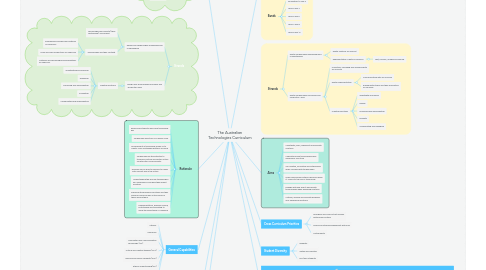
1. Design and Technology
1.1. Design thinking
1.2. Design solutions
2. Bands
2.1. Foundations to year 2
2.2. Years 3 and 4
2.3. Years 5 and 6
2.4. Years 7 and 8
2.5. Years 9 and 10
3. Strands
3.1. Design and Technologies Knowledge and Undersanding
3.1.1. Technologies and society (their relationship) ACTDEK001
3.1.2. Technologies and their contexts
3.1.2.1. Engineering Principles and systems ACTDEK002
3.1.2.2. Food and Fibre Productions ACTDEK003
3.1.2.3. Materials and Technologies Specialisations ACTDEK004
3.2. Design and Technologies processes and production skills
3.2.1. Creating solutions
3.2.1.1. Investigating and Defining
3.2.1.2. Designing
3.2.1.3. Producing and Implementing
3.2.1.4. Evaluating
3.2.1.5. Collaborating and implementing
4. Rationale
4.1. Ensuring all students learn how technology has
4.2. Technology affects us on a global scale.
4.3. Development in technology allows us to create more sustainable patterns of living.
4.4. Technology has the potential to transform,restore and sustain future societies and environments.
4.5. Develop skills in how to respond to needs both current and in the future.
4.6. Understanding the process technologies are developed in and how they impact societies.
4.7. Exploring technological solutions and their personal values as well as the values of those around them.
4.8. Experimentation, problem solving, prototyping and evaluating to show the importance of planning
5. General Capabilities
5.1. Literacy
5.2. Numeracy
5.3. Information and Communication Technology (ICT)
5.4. Critical and creative thinking (CCT)
5.5. Personal and social capability (PSC)
5.6. Ethical understanding (EU)
5.7. Intercultural understanding (ICU).
6. Links to other learning areas
6.1. English
6.2. Mathematics
6.3. Science
6.4. History
6.5. Geography
6.6. The Arts
6.7. Physical Education
7. RESOURCES: January 10, 2018 – Teaching in the Technologies Curriculum
8. Digital Technologies
8.1. Computation thinking
8.2. Information system
8.3. Design digital soloutions
9. Bands
9.1. Foundation to Year 2
9.2. Years 3 and 4
9.3. Years 5 and 6
9.4. Years 7 and 8
9.5. Years 9 and 10
10. Strands
10.1. Digital Technologies Knowledge and Understanding
10.1.1. Digital Systems ACTDIK001
10.1.2. Representation of data ACTDIK002
10.1.2.1. Text, numeric, images and sounds
10.2. Digital Technologies Processes and Production Skills
10.2.1. Collecting, managing and analysing data ACTDIP003
10.2.2. Digital Implementation
10.2.2.1. Communicating data ACTDIP003
10.2.2.2. Engage with others and their information ACTDIP006
10.2.3. Creating Solutions
10.2.3.1. Investigate and define
10.2.3.2. Design
10.2.3.3. Producing and implementing
10.2.3.4. Evaluate
10.2.3.5. Collaborating and managing
